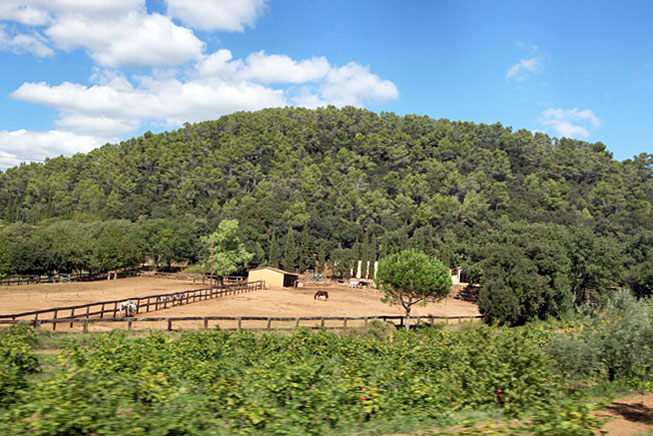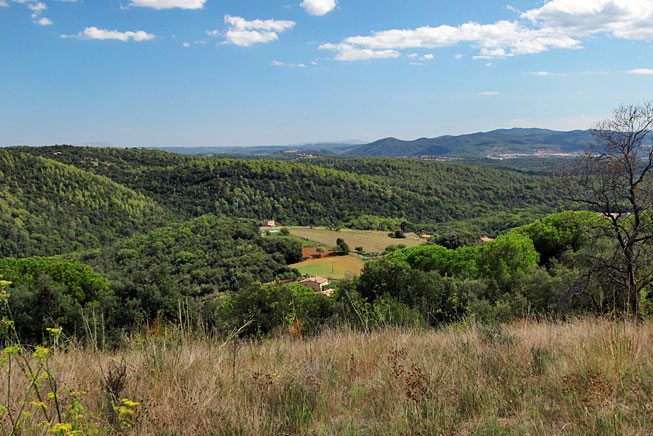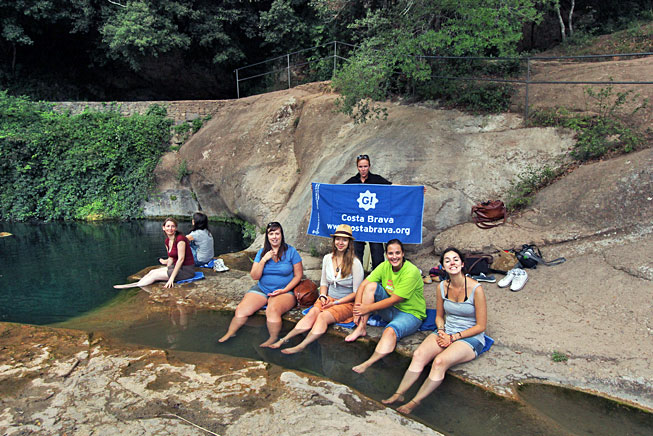From the outset, I knew I was in trouble in Costa Brava, Spain. Not only did I love the people, architecture, and scenery, I loved the food! As if conspiring to pierce my Achilles heel, Costa Brava Girona Tourism Board, the main sponsor and host of the Travel Blog Exchange Conference I had come to attend, focused on the cuisine of Catalonia. It began with an opening night party, held at the 12th century Castell de Sant Gregori. I stuffed my face with lacy fans of Parmesan cheese that dissolved on the tip of my tongue and devoured an exquisite mushroom risotto. I swooned over mango and chocolate desserts, all prepared by El Cellar de Can Roca, said to be the second best restaurant in the world – no argument from this aficionado.
By the end of the conference I’d gained five pounds and there was more to come. A press trip on the heels of TBEX would keep me gorging on the cuisine of Catalonia more or less continuously for the next three days. Our itinerary included sampling organic yogurt at a local dairy farm, a traditional Catalonian breakfast at a 700-year old farm, and a catered party at the ancient Arab Baths in Girona. On day six I rolled out of bed like a beached whale and perused the day’s schedule, overjoyed to discover we would be hiking volcanoes in the Llemena Valley. Finally, a reprieve that would allow me to work off the bulge that was beginning to creep over my waistband!

A short while later our bus ground to a halt and spit us out in front of a peaceful farm that squatted at the base of a densely forested humpbacked hill. We climbed steadily to a ridge where the panorama revealed itself; from east to west, a string of eroded hills ringed the valley like a circle of overturned bowls. Though placid on this sunny morning, 10,000 years ago these now extinct volcanoes spewed lava in living testimony to the fiery forces that formed this fertile valley.

We descended through loose scree, grasping for tree limbs to keep from tumbling headfirst down the slippery slopes, finally arriving in a leaf-littered clearing punctuated by a giant cork trees that are still tapped for cork used to seal wine bottles. Emerging from the dappled clearing we crossed a road and continued down to Torre de Canet d’Adri, a natural spring with a source buried deep beneath nearby Rocacorba Mountain. The crystal emerald waters flow into the volcanic gorge and collect in its bellybutton. My companions gratefully stripped off shoes and socks and soaked their weary feet in it chilly waters as I ran around taking photos, determined to work off as many calories as possible.

After our brief rest we headed back uphill, emerging aside Sant Vicenç, a 10th to 11th century Romanesque church in the village of Canet d’Adri. Grinning, our hosts led us to the interior courtyard of the massive stone structure, where ivory china and crystal goblets set on a table covered with peach colored linen. We were about to sit down to lunch, but this would be no ordinary feast.

The Remença Uprising, one of the most important historical events of the middle ages, took place in and around the Llemena Valley. During the second half of the 15th century, the peasants of Catalonia were among the first to fight for the abolition of “mal usos,” taxes levied on them by feudal lords of the region.
Our hosts explained that the Remenças were serfs, bound to the soil. “If you wanted to get married, you had to pay a tax. If you wanted to have a baby, another tax. And so on – everything required paying a tax.” They toiled under harsh physical and economic burdens and their wives and daughters were open to assaults from nobility, including being forced to work as wet nurses for nobles’ wives. The long-suffering Catalan peasants finally rebelled in what would become known as the War of the Remençes. Today, Remença history is celebrated by the Coal Gastronomy Association, a collaboration between local restaurateurs who are determined to preserve the rustic food traditions of that era.

I took my place at the table and scanned our lunch menu: Coca de Recapte with cheese; fresh salad; grilled vegetables; fig stuffed with foie; snails; rabbit with aromatic herbs; wild boar with chestnuts; chicken with wild mushrooms; and for desert crema Catalana wth Ratafia (a liquor made with traditional herbs and fruit) and cottage cheese with honey, nuts and dried fruit.
Can’t view the above slideshow of the Remença lunch in Canet d’Adri, Spain? Click here.
So much for working off calories. And then I dove in with relish. Fortunately, being a vegetarian meant I could bypass all the meat, but I made up for it with the desserts. Three hours later, with distended stomach, I boarded the bus for the ride back to Girona. By the light of a sky fired golden-orange I dug into my pack and perused the itinerary for the following day: Shopping in the grocery market and show cooking by a local chef. I groaned inwardly and just accepted that I would be eating my way through the cuisine of Catalonia, Spain for another few days. There are lots worse things in life than a few extra pounds.
My tour around Girona, Spain was hosted by Costa Brava Pirineu de Girona. However, the receipt and acceptance of complimentary items or services will never influence the content, topics, or posts in this blog. I write the truth, the whole truth, and nothing but the truth. If you love to hike, the Catalonia Region of Spain is an ideal destination for you. To receive a special “Hiking Routes” booklet or for more information about gastronomy in the Llemena Valley, contact the Girones Centre de Visitants (Gerona is the Catalan spelling of Girona) Avinguda de Franca, 221, Sarria de Ter, Girona 17840, Phone:972 011 669 (country code +34), Website with contact form: http://www.turismegirones.cat/uk/index.html.

I loved the detailing with the food there and the idea of lunching in the interior courtyard of the church! Spain has always been on my wishlist. 🙂
Hi Aradhana: Spain is one of my favorite destinations and I particularly adore the Costa Brava area of Catalonia. It offers such beauty and diversity and has a little something for everyone.
That food looks amazing and makes me hungry (its almost lunch time).
Wow! Food is one of my favorite parts of traveling, and especially in Spain. Those pictures look amazing! I’m impressed you only gained 5 pounds. Definitely looks like amazing food and a great part of Spain to explore.
And I’m having a heck of a problem shedding those five pounds, Ali, since I’m still in Spain and just finished six weeks in France. Bread, cheese, oil – I can’t get enough of it.
Lovely post Barbara, thank you!
You’re welcome, Xavier. I’ll see you soon as I arrive in Girona tomorrow and I’ll be coming by the office for yogurt!!!!!
Haha being anywhere in Europe goes hand in hand with putting on a few extra kilos! Sounds so good though. Lovely pictures.
Hi Our Journey to the Sea: Ain’t it the truth. I usually lose weight as I travel, but it’s much harder in Europe for some reason.
While the food looks superb I love the story of the rebellion by the local farmers. It is interesting how history continues to repeat until this very day – people if down-trodden enough rear up and rebel when they get their chance to at least partially address the imbalance. Congrtas to the area for keeping a millennium old culture alive so beautifully (and calorifically!!).
Being a Foodie I never feel shy to try every taste. Seems like Spain would be a heaven like place because of My Addiction to Food!
Appetizing! I think Spain is perfect for my family vacation!
Hi Golfzoo: I agree! Spain is the perfect vacation for anyone.
All we did in Catalonia was eat! (ok, not all, but my waistline afterwards would disagree..)
Amazing style of writing! You have such a rich vocabulary. You should definetely write books 🙂
I knew something about Girona but now I have a much better image about it. I found the history part about the Remenças very interesting. Thanks for presenting it to us! 🙂
Thank you Izzy Berry! That is a lovely thing to say to a writer. One of these days I’m going to find time to sit down and write that book I’ve been threatening to write for years.
What a lovely post to remind me how great our time in Girona was! I could definitely eat those dishes again…
I loved my time in Spain last year, but have yet to visit Girona! Actually I never heard of it before.. Thanks for your post!
You’re welcome, Paul. Girona (and Catalonia as a whole) is a world apart from the rest of Spain. I suspect you’d like it.
Looks like you ate your way through some delicious-ness – Costa Brava really is a gastronomic paradise
My goodness – I love the look of all that food. In fact you’ve just given me a couple of ideas for Sunday lunch!
Hi Julie: You have me smiling. Though after all the food in Girona, I felt like I wouldn’t need to eta for a week.
Anyplace that serves up tasty looking wild meat like that is high on my travel list….hello Girona, I’ll be visiting you one day soon!
Hi Red Hunt: You’ll love it! Any of the culinary things I did in Girona – the organic dairy farm, typical Catalonian breakfast at Can Dionis Farm, or even this Remença banquet can be organized for any tourist, with the help of Costa Brava Tourism, The Gironas County Tourism Board, or the Ajuntament of Girona (town).